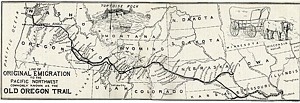The Oregon Trail, the 2,000-mile (3,200 kilometer) route across the Great Plains and the through the Rocky Mountains that was the path for thousands of emigrants to the Columbia River Basin in the 1840s, had its origin, literally and figuratively, in the 1812 journey of Robert Stuart who pioneered the route essentially in reverse. Stuart, a partner in the Pacific Fur Company, left Astoria, the outpost he helped to establish the previous spring at the mouth of the Columbia River, on 29 June. His purpose was to report to Pacific Fur Company President John Jacob Astor in New York on the Astoria settlement.
Stuart and his six companions traveled up the Columbia, over the Blue Mountains to the Snake, up the Snake to the Portneuf in present-day southeastern Idaho, then south to the Green River and along the southern flanks of the Wind River Mountains. Stuart, who had arrived at Astoria on Astor’s ship Tonquin, here left the trail his associates had taken on their overland journey to Astoria and went south rather than directly east over the Wind Mountains. Thus on October 22, 1812, having turned east, he discovered the level crossing of the Continental Divide at South Pass that would prove crucial to future migrations of people and their wagons and livestock along the Oregon Trail. Rather than following the rugged trails of the fur brigades through the Green Mountains, wagons now could roll around them
From South Pass, Stuart’s party descended eastward to the Platte River and then to the Missouri, reaching St. Louis on 13 April 1813, “all in the most perfect health after a voyage of 10 months from Astoria,” he later wrote. Within two weeks a newspaper in St. Louis reported on the journey, commenting optimistically: “... it appears that a journey across the continent of N. America might be performed with a waggon, there being no obstruction in the whole route that any person would dare to call a mountain in addition to its being much the most direct and short one to go from this place to the mouth of the Columbia river.” Thus the stage was set, the match was lit, for the great explosion of westward migration that would follow in a few decades.
The route that became known as the Oregon Trail, or more precisely the Oregon and California Trail, as branches led to northern and southern California, began at Independence, Missouri. Ultimately, the Oregon part of the trail ended at Oregon City, Oregon, on the Willamette River south of Portland. Until 1846, however, the trail ended at The Dalles, where emigrants loaded their belongings onto rafts for the trip down the Columbia to the Willamette and from there to Oregon City. The river voyage only added to the dangers of the trip, and often the rafts had to be lined through the falls of the Cascades. Many emigrants settled at Oregon City; many others continued south to the Willamette Valley.
The trail from Independence to Oregon City crossed portions of six present-day states. The first 16 miles were in Missouri, then the trail crossed into Kansas for 165 miles, Nebraska for 424 miles, Wyoming for 491 miles, Idaho for 510 miles and finally Oregon for 524 miles.
Marcus and Narcissa Whitman were the first emigrants to make the trip with a covered wagon, in 1836. They traveled with a fur brigade of the Hudson’s Bay Company. A man named Joel Walker is believed to the first to have made the trip with a family, in 1840. The first wagon train of emigrants, headed by physician Elijah White, arrived in Oregon in 1841. After that, wagon trains made the trip annually, leaving Missouri no later than April 10 in order to take advantage of prairie grasses for their livestock and to arrive in Oregon in time to build cabins and plant their first crops before winter. The trip typically took between four and six months.
1843 was the year of the “Great Migration,” the largest group of emigrants yet to take the trail -- about 800 people with 120 wagons and 5,000 cattle. In 1847, the emigrants totaled about 4,500. Emigration continued for 25 more years, until the first of the transcontinental railroad line, the Union Pacific building west from Nebraska and the Central Pacific building east from California, was completed and westward travel became easier and faster. By the dawn of the 20tth century the trail largely was a memory. In places near the Columbia River---parts of Eastern Oregon near Pendleton, and at the Whitman Mission near Walla Walla, for example---wagon ruts remain visible.
Commemoration of the trail began in 1906, when Ezra Meeker, an Oregon pioneer who arrived on the trail in 1852, organized communities to erect trail markers. In 1978, Congress designated the route the “Oregon National Historic Trail.” Today the Oregon Trail and the history of emigration to Oregon are commemorated at museums including the National Historic Oregon Trail Interpretive Center at Baker City, Oregon; the Whitman mission historic site; the Tamastslikt Cultural Institute on the Umatilla Indian Reservation east of Pendleton; the Columbia Gorge Discovery Center at The Dalles; the reconstructed Fort Vancouver at Vancouver, Washington; and the End of the Oregon Trail Center in Oregon City.



